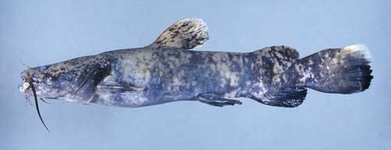Pylodictis
Pylodictis olivaris
Flathead Catfish
Larry PageIdentification
In all individuals except large adults, the caudal fin of the Flathead Catfish has a white tip on the upper lobe. The head is wide and flat, and all individuals except juveniles have the lower jaw projecting beyond the upper jaw. The body is slender and slightly compressed with small eyes on top of the head. The adipose fin is short and high with the rear end free from the back. The body is yellow to dark purple-brown with black or brown mottling above and white to yellow below. The chin barbels are white to yellow, and the fins are mottled. The anal fin is short and rounded with 14-17 rays. The caudal fin is rounded or slightly notched. The premaxillary tooth patch has a backward projection on each side. To 61 in. (155 cm) total length.
Range
Found in the lower Great Lakes and Mississippi River basins from western Pennsylvania to the White-Little Missouri River system in North Dakota and south to Louisiana. Also found on the Gulf Slope from the Mobile Bay drainage in Georgia and Alabama, to Mexico. The Flathead Catfish has been introduced elsewhere in the United States and is generally common.


Native distribution of Pylodictis olivaris. © Larry Page
Habitat
Flatheads are found among logs and around debris in pools associated with low- to moderate-gradient rivers, lakes, and impoundments. Young are found in rocky and sandy runs and riffles.
Similar Species
Other large catfishes, including the Channel Catfish, Ictalurus punctatus, and Blue Catfish, I. furcatus, lack the mottled color pattern of the Flathead, the white tip on the upper lobe of the caudal fin, and the projecting lower jaw.
About This Page
Larry Page

Florida Museum of Natural History, Gainesville, Florida, USA
Correspondence regarding this page should be directed to Larry Page at and Griffin Sheehy at
Page copyright © 2007 Larry Page
All Rights Reserved.
- First online 23 May 2007
- Content changed 23 May 2007
Citing this page:
Page, Larry. 2007. Pylodictis. Pylodictis olivaris . Flathead Catfish. Version 23 May 2007 (under construction). http://tolweb.org/Pylodictis_olivaris/69915/2007.05.23 in The Tree of Life Web Project, http://tolweb.org/








 Go to quick links
Go to quick search
Go to navigation for this section of the ToL site
Go to detailed links for the ToL site
Go to quick links
Go to quick search
Go to navigation for this section of the ToL site
Go to detailed links for the ToL site